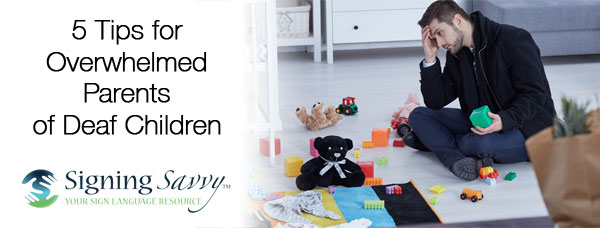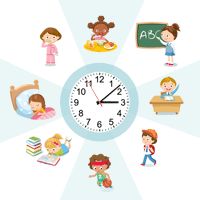
5 Tips for Overwhelmed Parents of Deaf Children
Overwhelmed… The look on the faces, or the words that came out of the mouths of almost every parent of a deaf child I’ve ever met with during a home visit. The first thing I want to say is, “Move over because you aren’t alone on that bench,” and secondly, “Stop feeling guilty about anything and everything and lets make a commitment and move forward now, looking in the rearview mirror is only good to learn from, NOT to see your future.”
Many parents seem to carry this tremendous amount of guilt about the way things are going with their parenting of their deaf child. They know that it’s a bit of a different “play book” than with their hearing children, and the fact that their deaf child’s native language isn’t even their own, causes great confusion and frustration. The fact that they have to now adapt into this whole new culture and community in order to gain a greater understanding of their deaf child’s identity can be very… overwhelming!
My first suggestion is to acquaint yourself with someone who has a good (nonbiased) understanding and connections with the Deaf Community in your area (if there is one). Contacting the school systems and the interpreting population or County offices can be a helpful resource to begin.
There are so many slippery slopes that hearing parents of newly identified deaf children can encounter. I once had a mother come into my classroom in tears because she referred to her daughter as “hearing impaired” in a setting that included many people from the Deaf Community and she was pretty much attacked by them and had no idea why. I had to explain to her that although both the medical and educational systems have used that terminology, it is NOT the accepted, preferred terminology of the Deaf Community and she needs to avoid the use of the word “impaired” if she wants to be on good terms with the community. Instead of using the term "hearing impaired," simply say "deaf" or "hard of hearing."
I had another set of hearing parents mortified at a suggestion that was said to them – it was said to them that because their child was deaf, they should give them up for adoption to a deaf family so that they could be “properly raised in a home where sign is their first language.” I had to explain to them also that although that is pretty extreme, it shows how strongly some deaf people feel about the idea of proper communication and the use of sign language, and also the years of ignorance on the part of the hearing community that shaped the landscape. It is then that I recommend the book Deaf Heritage: A Narrative History of Deaf America by Jack Gannon. This book has been around for a long time, yet gives a pretty clear explanation of Deaf history and why some of these strong feelings still exist today.
I guess the idea I like to get across to parents at this point is this: If you commit to communication with your deaf child that includes sign language as their primary mode of communication, then commit to learning it yourself! No, it’s probably not going to be easy, but what part of parenting is? Here are some tips that can help:
1. Learn sign langauge along with them.
- Learning sign language as your child is learning it is helpful and, if possible, it is even better if you can keep yourself a few steps ahead of them. This can be easier when your child is very young and just learning to communicate. If your child is older, although it’s going to be more challenging, it’s never too late! Try to learn sign language as they are learning it, even if you aren’t able to keep up with their pace of learning.
2. Tackle things in logical chunks.
- Starting off, the goal isn’t to know arbitrary vocabulary for a test, or even to be fluent (that’s something to work towards). You just want to be able to communicate with your child, so focusing on the vocabulary you need to do that is what is most important.
- Start with experiences you share together and work from there.
- Think about your interactions with them, the language and vocabulary that would be involved in those daily interactions.
- Create Signing Savvy word lists that focus on key vocabulary and then review those lists and use the digital flash cards and quizzing features to help you become familiar with the vocabulary.
3. Practice, practice, practice.
- Sign with your child. You can't learn if you don't try.
- Along with using word lists to customize vocabulary you want to learn, use of the Signing Savvy Member App on your smart phone to look up signs you don't know while you're on the go. Using the App will allow you to become more fluent.
- Watch our videos of ASL glosses to see full sentences and phrases signed and to start to get more comforable with ASL syntex.
4. Reach out for help.
- There are people and programs to help. It takes time and a little research to figure out who the local people and what the local programs are, but it can be worth the investment of effort.
- The IDEA federal law requires every state to have programs for children with delayed development (such as delayed language development) for both infants and toddlers (birth to 3 years old) and children and youth (3 to 21 years old).
- Contacting the school systems and the interpreting population or County offices can be a helpful resource to begin.
- Stay in touch with any teachers, interpreters, or other aides or specialists that work with your child so you can stay in the loop and on the same page. Not only is it helpful to get updates and feedback from these people that work with your child, but communicating about what’s going on at home with them can also help form a better plan to meet their needs.
- If possible, acquaint yourself with someone who has a good (non-biased) understanding and connections with the Deaf Community in your area (if there is one).
5. Create a support system.
- In addition to reaching out for help to people who can work with your child (or already do), capitalize on your close social network to create a support system. Encourage others to learn sign language and to use it to communicate with your child, especially close family and friends that are a regular part of you and your child’s life.
- You can share the Signing Savvy word lists you have already created with family and friends to help them get started with basic vocabulary (they do not need to be Signing Savvy members to view your lists).
- You can also create special word lists tailored for people like babysitters or substitute teachers, or for specific events, like Thanksgiving dinner and share that list with everyone that will be coming. Sharing word lists gives people an actionable way to learn some vocabulary and, more importantly, is a reminder that communicating with your child is important and that one of the best ways they can help is to support language learning and the use of sign language.
I can guarantee your child will appreciate the effort and the ability to communicate with their parents. Stick with it, nothing happens overnight. You can’t just try it out and then back out. It’s something that has to be worked on and added to daily. The learning never ends, but the rewards can be great!
Books Recommended In This Article
ADVERTISEMENTS
 5 Tips for Creating a Language Rich Environment for Deaf Children Through Routines and Consistency
5 Tips for Creating a Language Rich Environment for Deaf Children Through Routines and Consistency Practice American Sign Language (ASL) With an ASL Expert Through Video Chat
Practice American Sign Language (ASL) With an ASL Expert Through Video Chat The Importance of Early Exposure to American Sign Language with Deaf Children
The Importance of Early Exposure to American Sign Language with Deaf Children






